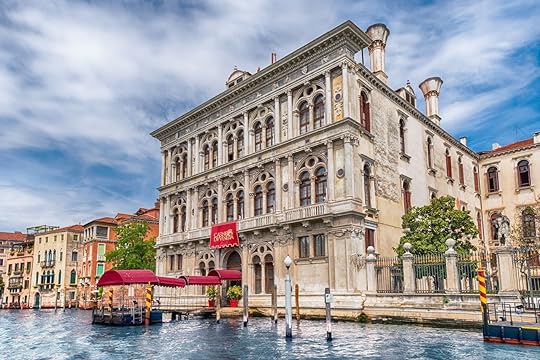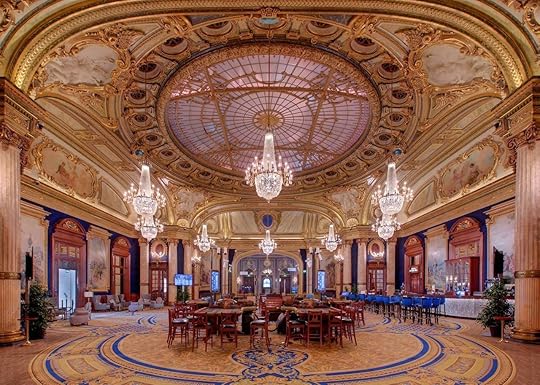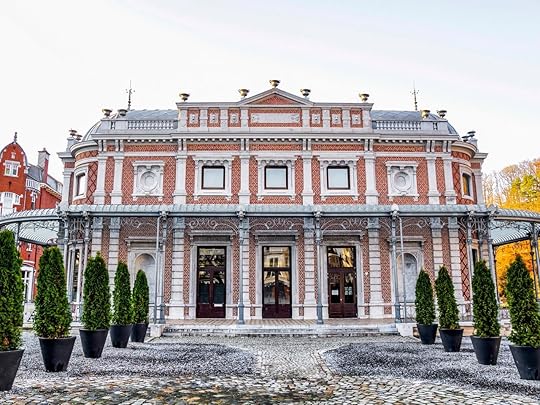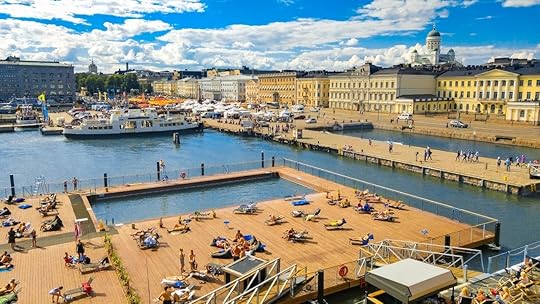Matador Network's Blog, page 1055
July 16, 2019
Air France serving new meals

With many airlines now introducing healthier, more substantial options, complaining about airplane food is almost an outdated issue. Air France is the latest airline to step up its food game by partnering with American chef Daniel Rose, who used to own Spring, a restaurant in Paris. More recently, he has received a Michelin star for his Le Coucou restaurant in New York, which specializes in French cuisine. Now, he’s taking his talents to the Air France in-flight menu, to bring some authentic French flavor to its flights.
As reported by Forbes, Rose said, “I am honored to be partnering with Air France, the airline that set me on my culinary journey 21 years ago. We look forward to sharing our version of classic French meals at 30,000 feet that are as comforting and as delicious as in my restaurants.”

Photo: Air France
If you’re booked on an Air France flight in September or later, you’re in luck. Business-class passengers flying from any of the airline’s North American gateways will be able to indulge in the new menu items, including a rich poultry gratin with onions, poultry pâté with foie gras, and cod filet with turnip and beurre blanc sauce. And in case frequent flyers are concerned that the new fare will get a bit stale, three new dishes will appear on the menu every two months.
US flights aren’t the only ones getting the star chef treatment. On other international routes, menus will feature creations by other chefs, like Guy Martin, Anne-Sophie Pic, and Andrée Rosier. 

More like this: The best (and worst) airline food in the world, according to a pro airline food reviewer
The post Air France to serve meals created by Michelin-starred chef appeared first on Matador Network.

The most beautiful casinos in Europe

Casinos typically conjure images of flashing lights and wailing slot machines, but not all of them fit that Las Vegas stereotype. Before the advent of tacky casino complexes, smoke-filled sportsbooks, and price-gouging buffets, gambling was a hobby reserved for society’s upper-crust (the only ones with money to waste), and it took place in some fancy decor. From a German casino that inspired and financially drained one of Russia’s most famous authors to the oldest casino in the world in Venice, these following classy establishments are more than just relics of the past with strict dress codes; they offer an authentic old-world experiences that really transport you back in time — while taking all of your hard-earned money on a roll of the dice.
1. Casino di Venezia, Italy

Photo: Marco Rubino/Shutterstock
No European casino tour is complete without a visit to the oldest casino in the world. Casino di Venezia, located right on the Grand Canal in Venice, opened in 1638 and still welcomes gamblers today. Originally, the building served as a theater called Theatre Saint Moses, which had a wing for gambling during intermission. This small wing, however, was a catalyst for the advent of casinos in Venice, and by 1744 there were over 120 of them around the city. During its long lifespan, the building also functioned as a home for Italian royalty, and even a getaway for composer Richard Wagner in the mid-19th century.
The casino was designed with a classic Italian look, with mirrors by Murano glassmakers, embellished pillars, felt ropes for handrails, and a private garden overlooking the canal. It’s also used as a venue for the Venice Film Festival. The building is immense, with vast spaces for slot machines, poker, roulette, and other table games, as well as rooms designated for dining and entertainment. As a nod to Wagner, there’s the Wagner Restaurant serving classic Italian fare. A free boat shuttle service is also available to ferry guests to the casino from all over the city.
2. Casino de Monte-Carlo, Monaco

Photo: Monte-Carlo SBM/Facebook
In part thanks to the casino’s appearance in the Never Say Never, Casino Royale, and GoldenEye Bond films, Casino de Monte-Carlo is unquestionably the most famous casino in Europe. Opening in the 1850s to generate income for Monaco’s royal Grimaldi family, the Beaux-Arts style building is defined by its gilded ceilings, crystal chandeliers, frescoes, and tapestries.
In keeping with its stylish interior and highbrow reputation, the Casino de Monte-Carlo isn’t exactly a low-limit gambling establishment. You don’t have to be a Saudi prince or hedge fund manager to play here — although you probably do to afford Monaco’s astronomical yacht docking fees — but you do need to adhere to a dress code, pay a modest 10-Euro fee, and behave respectably.
Even if you’re not a gambler, the casino is open to groups and tours every day from 9:00 AM to 1:00 PM. A simple stroll through the gaming rooms will be enough to make you feel like part of Monaco’s high society, and, if you don’t want to go in, the lineup of exotic cars parked outside radiates enough razzle dazzle for everyone to get their fill.
3. The Ritz Club, London

Photo: The Ritz Club
The title of Europe’s most exclusive casino probably belongs to London’s Ritz Club. This members-only casino is located in the basement and former ballroom of The Ritz Hotel. Inside, you’ll find a gaming salon furnished with rich tapestries, red carpets, chairs with crushed velvet cushions, and ornate domed ceilings. There are also more intimate private rooms for especially high rollers — though pretty much everyone at this casino is a high roller.
The club dates back to 1909 and has gone through several iterations, but has served as a casino since 1977. To join the club, you must submit an application form and be recommended by an existing member. Given that the club has been frequented by celebrities like Johnny Depp, Dame Shirley Bassey, and Kerry Packer, membership isn’t easy to obtain. The dress code is strict: Men are required to wear a jacket and collared shirt at all times.
4. Casino Wiesbaden, Germany

Photo: Spielbank Wiesbaden
Germans may be stereotyped as a sensible kind of people, but even the most practical spender can get sucked into spending some dough when a gambling establishment has the charms of the neoclassical Casino Wiesbaden. First established in 1771, Casino Wiesbaden is now located in the wine parlor of the Kurhaus spa house — the social center of old Wiesbaden. Like Monte Carlo, visitors will be immediately stricken by its crystal chandeliers, as well as its cherry woodwork and intimate, refined atmosphere. Renowned Russian author Fyodor Dostoevsky fell victim to the casino in 1865, when he gambled away all his belongings there, and was inspired to write his famous novel The Gambler. You can even see the roulette wheel where he lost all of his roubles, carefully preserved in a glass case at the casino’s entrance.
Men are asked to dress in a shirt and jacket. Jeans are unacceptable, though trousers can be rented from the cloakroom for a fee. There are two bars in the casino if you don’t feel like following in Dostoevsky’s footsteps (or in case you already have).
5. Casino de Spa, Belgium

Photo: Stanislava Karagyozova/Shutterstock
Spa, Belgium, is the perfect place to gamble. The town is not only the home of one of the world’s oldest casinos, but is also Belgium’s premier relaxation destination. Filled with restorative cold springs, Spa has been a vacation destination for the wealthy since the 14th century. Even the term “spa,” which has become ubiquitous, derives from the name of this town.
The Casino de Spa is actually connected to the famous cold springs, making it easy for visitors to take a dip after they’ve lost their shirt at the craps table. Built in 1763, the casino was a focal point of Spa’s society until 1789, when the Liege Revolution, Prohibition, and a devastating fire led to its decline. The building has since been reconstructed, and restored to its original splendor. The casino features a ballroom, cultural center, theater, and several restaurants, including La Brasserie du Casino, with panoramic views of the city. 

More like this: The ultimate guide to vacationing in Monte Carlo like James Bond
The post The most glamorous old-world casinos in Europe appeared first on Matador Network.

London latest skyscraper axed

A building project named the “Tulip,” proposed last year as the newest addition to London’s skyline, just got rejected. The flower-shaped building was slated to be the second tallest building in western Europe at 1,000 feet, but London Mayor Sadiq Khan has just vetoed the project, citing its negative aesthetic impact upon the London skyline.

Photo: Foster + Partners
A spokesperson for Khan said, “The mayor has a number of serious concerns with this application and having studied it in detail has refused permission for a scheme that he believes would result in very limited public benefit. In particular, he believes that the design is of insufficient quality for such a prominent location, and that the tower would result in harm to London’s skyline and impact views of the nearby Tower of London world heritage site. The proposals would also result in an unwelcoming, poorly designed public space at street level.”
Duncan Wilson, chief executive of Historic England, echoed these concerns. “This building,” he said, “a lift shaft with a bulge on top, would damage the very thing its developers claim they will deliver — tourism and views of London’s extraordinary heritage.”

Photo: Foster + Partners
Topped by a glass bud with 360-degree viewing galleries, a bar, and restaurants, the building was also supposed to feature a small park, rooftop garden, and sky bridges between observation decks. Architects claimed it would serve as a cultural and educational resource, furthering local government plans to create a “culture mile” to attract more visitors to London’s financial district. 
This article was updated on July 16, 2019.

More like this: London’s newest skyscraper will have a climbing window
The post London’s proposed ‘Tulip’ building just got the axe appeared first on Matador Network.

Boeing 737 Max undergoes rebranding

To say the 737 Max has received bad press lately would be an understatement, as the aircraft’s faulty flight control system has led to two separate, fatal crashes, one in Indonesia in October and another in Ethiopia in March. Following the mass grounding of all Boeing 737 Max 8s, Boeing is now rolling out its new and (hopefully) improved versions, with one important difference — the livery reads “737-8200” and not “737 Max.”
The change was noticed after photos were released of the new 737 being prepared for delivery to Ryanair. The European budget airline ordered 135 new 737 Max models, with five being scheduled for delivery this fall, reported .
There has been no official comment from either Ryanair or Boeing on the speculations of rebranding, though photographs of the aircraft clearly show the name change. Since the livery is entirely at the discretion of the airline, not the manufacturer, the “737-8200” designation is the work of Ryanair, likely eager to separate itself from associations with the troubled model.
HI-Res Photos: The MAX name has been dropped from the high capacity version of the #737MAX8 that @Ryanair has on order. pic.twitter.com/3q5QBN0TTg
— Woodys Aeroimages (@AeroimagesChris) July 15, 2019
Currently, Boeing is in the process of upgrading the aircraft’s flight control system, but another potential risk of the 737 Max 8 has been identified by the Federal Aviation Administration (FAA) in the aircraft during simulator tests.
The FAA tweeted on June 26, 2019, “On the most recent issue, the FAA’s process is designed to discover and highlight potential risks. The FAA recently found a potential risk that Boeing must mitigate.” And although the specifics of the problem are still murky, a source told the BBC, “During simulator testing last week at Boeing, FAA test pilots discovered an issue that affected their ability to quickly and easily follow the required recovery procedures for runaway stabiliser trim (i.e., to stop stabilisers on the aircraft’s tail moving uncontrollably). The issue was traced to how data is being processed by the flight computer.”
Boeing 737 Max 8s are grounded until the fall, but some say the aircraft is unlikely to fly before 2020. 

More like this: Why you have to put your shades up for takeoff, and other answers to your burning airline questions
The post Grounded Boeing 737 Max planes are getting rebranded appeared first on Matador Network.

July 15, 2019
The best saunas to visit in Helsinki

Finland has frequently been ranked as the happiest country in the world. There are a lot of reasons for this, but one of them may be that Finns know how to slow down and relax. After all, Finns invented the sauna. In a country of 5.5 million, there are over three million saunas. In other words, just about every Finn is addicted to löyly, the rush of warmth you feel when water hits the sauna rocks and produces a burst of steam.
No trip to Finland would be complete without enjoying a Finnish sauna. While Finland has an almost limitless number of saunas, the capital Helsinki itself has an impressive selection of public saunas for your experience in Finnish culture.
A bit on sauna etiquette
Saunas are deeply rooted in Finland’s culture and have existed there for over 2,000 years. In addition to being places to warm up and relax, they were also places to get clean — and cleanliness is an important Finnish value. Always shower before entering the sauna. Also, note that sauna time shouldn’t be rushed. You’ll want to shower, get in the sauna until you are nice and sweaty, and then cool off — either by taking a cold shower, jumping into a sea or lake, or just spending some time outside — before heading back in for another round.
You’ll find that public saunas in Helsinki are usually filled with mostly Finns, many of whom speak fluent English, so you can strike up a conversation as you chill in the hot steam room. In many saunas, you’ll go naked. If you’re planning to head outdoors, though, you’ll want that swimsuit. Also, saunas can be part of social or work events, so they may include a cold beer during the cool-off sessions, or even a meal afterward.
Unsurprisingly, there’s a huge diversity of places you can enjoy a relaxing, naked steam amongst locals. Below are the highlights of each category. Just note that, for many saunas, you may need you to reserve a time slot in advance. Make sure you check the websites.
Allas Sea Pool — perfect for travelers

Photo: fujilovers/Shutterstock
Located right next to the Market Square, floating atop the Helsinki harbor, is Allas Sea Pool. Inside the relatively new wooden structure — it opened in late 2016 — you can find good food and saunas, and outside are hang-out areas and two massive pools: one heated pool and one with seawater. There’s a men’s sauna, a women’s sauna, and a mixed-gender sauna (where you’d be wearing a swimsuit) that can also be rented as a private sauna for certain events. As you jump into the pool to cool down from the heat of the sauna, you can watch ferries pass through Helsinki harbor with the hubbub of central Helsinki as their backdrop.
If you want to visit a sauna within walking distance of Helsinki’s most famous landmarks and take in a great city view, head to Allas. A single adult visit is 14€ (about $15.75). Even if you decide to sauna elsewhere in Helsinki, you should still climb to the top of the wooden Allas building for sweeping views of Helsinki Harbor. It’s free to enter if you aren’t planning to use the pool or sauna, although you may want to buy a beverage to sip on as you enjoy the view.
Kotiharjun Sauna — a traditional, wood-fire sauna
View this post on Instagram
Luxury hotels with animal encounters

Sometimes at the end of a long day, you just want to cuddle with a cow.
Of course, most of us lack any actual cows to cuddle with, so much like scuba diving and drinking on Tuesdays, it’s the sort of thing you save for vacation. As are playing with a lot of other animals we don’t have at home, whether they’re sea turtles, alpacas, racehorses, and spider monkeys. Granted, animal tourism can sometimes raise questions as to its ethics, but many hotels around the world have found ways to play with our furry friends while not disrupting their natural states, often benefiting them through charitable donations or adoption services. Here are 11 hotels around the world with just such programs that are cheaper than therapy.
1. Cuddle with cows in Upstate New York — Mountain Horse Farm

Photo: Mountain Horse Farm/Facebook
Don’t plan on getting much work done if you visit this horse farm in Naples, New York. The 33-acre bed and breakfast and horse sanctuary doesn’t have much in the way of WiFi or cell service, but it does have plenty in terms of playing with animals. Not only can you participate in Horse Clinics, where you learn from experts how to connect with these equine beauties, but you’ll also have the option to snuggle up to some of the farm’s rescue cows while they’re sleeping. The practice of “cow cuddling” is supposedly highly therapeutic and calming, a perfect activity at this country estate that’s a true digital detox.
2. Do yoga with puppies in Philly — The Logan Hotel

Photo: The Logan – Philadelphia’s Hotel/Facebook
Not that frenetic, face-licking puppies are exactly the ideal models for downward-facing dog, but at least they’ll give you something to focus on other than your aching hamstrings at The Logan’s puppy yoga classes. For a mere $25, you can take part in a 60-minute class where the Morris Animal Refuge brings a cadre of adoptable puppies to do yoga along with you. The class is led by Amrita Yoga, and the 90 spots are open to both hotel guests and anyone else who wants to join.
3. Snorkel with manatees in Florida — Plantation on Crystal River

Photo: Plantation on Crystal River/Facebook
There’s nothing quite as alarming — and then immediately adorable — as snorkeling above a river bottom, seeing that river bottom move, then realizing you’re swimming on top of an 800-pound manatee. But that’s par for the course in Crystal River, the best place in America to swim with manatees. At Plantation on Crystal River, a sprawling old estate on the west coast of Florida, you can meander out back to Crystal River Watersports and spend a morning communing with these gentle giants. Just resist the temptation to try and ride one: Not only is it highly illegal, but it’s also a guaranteed way to end up the lead in a “Florida Man” story.
4. Play with elephants in Thailand — Anantara Golden Triangle Elephant Camp & Resort

Photo: Anantara Golden Triangle Elephant Camp & Resort
Elephant rides are one of the dicier animal encounters you can have abroad, as some have gained reputations for less-than-ideal treatment of their animals. Not the case at the Anantara Golden Triangle Elephant Camp & Resort, which has rescued 20 elephants from previously unethical environments and works with the Golden Triangle Asian Elephant Foundation to ensure these elephants are well cared for. Guests of Anantara can stroll among the impressive giants, socializing with them while they play in the water and munch on tropical leaves. No riding is allowed, but it’s an up-close experience with elephants that’ll leave you feeling a lot better than if you’d mounted one.
5. Feed and hold chickens in Costa Rica — El Silencio Lodge and Spa

Photo: El Silencio Lodge & Spa/Facebook
The folks at El Silencio Lodge and Spa believe you should get to know the animals providing you your dinner. Or maybe it’ll turn you vegetarian, who knows? Either way, this luxe eco-lodge in Costa Rica’s cloud forest highlands gives you an opportunity to help out on the farm every morning, feeding the fish in the on-site trout pond and playing with free-range chickens. You’ll get to feed the chickens as well as cuddle them all you like, which may or may not affect what you order later in the day. No word if they let you cuddle the trout too.
6. Paddleboard and swim with sea turtles in Barbados — Colony Club

Photo: Elegant Hotels Group/Facebook
Snorkeling with sea turtles isn’t a difficult activity to come by. But the Colony Club along Barbados’s fabled Sunset Beach offers you something different: a full day excursion to a secluded restaurant where you’ll also get an insane core workout. Once a week the club offers a stand-up paddleboard and turtle swim excursion, where you’ll paddle out to the Lone Star Restaurant, enjoy a lunch on the beach, then jump in the water and swim with once-endangered leatherback and hawksbill turtles. After you’ve gotten as close to the turtles as you can in nature, you’ll paddleboard back, making for an enriching yet exhausting afternoon.
7. Adopt an animal in Palm Springs — Westin Mission Hills Golf Resort & Spa

Photo: The Westin Mission Hills Golf Resort & Spa/Facebook
Playing with an animal on vacation can be fun, but sometimes it leaves you wishing you could take that kissable little guy home. Well, the Westin Mission Hills in Palm Springs gives you animal encounters that’ll last for years with adoptable animals available in the hotel’s lobby. The program — done in conjunction with nearby Animal Samaritans — has found homes for over 100 dogs since its inception and will help you with the logistics of getting the animal home too.
8. Serve breakfast to spider monkeys in Guatemala — Las Lagunas Boutique Hotel

Photo: Las Lagunas Boutique Hotel
Anyone who’s ever returned to their room service breakfast and found it completely obliterated by monkeys knows they don’t wait for invitations to share in your food. You’ll have a far less frustrating experience at the Las Lagunas Boutique Hotel, located on over 300 acres of nature reserve rich in native flora and fauna. The hotel offers daily boat rides to Monkey Island, where you can watch the monkeys play in the jungle and feed them food that’s not from your breakfast tray. On the way, you’ll likely meet Margarita, the island’s most famous resident, who’ll hop from a tree right onto your boat, pose for pictures, and grab some snacks to go.
9. Hang out with alpacas in Peru — JW Marriot El Convento Cusco

Photo: JW Marriott El Convento Cusco/Facebook
This convent turned hotel is already one of the coolest hotel experiences you can have in Cusco, but it’s made even more memorable with a short drive to Awana Kancha. At this llama, alpaca, and vicuna farm, you’ll spend an afternoon feeding, petting, and generally interacting with its residents. After giving the good grass to your new four-legged friends, you’ll then get a live textile weaving demonstration from local women. Once back at the hotel, it’s time to meet Panchita, a cuddly baby alpaca who makes daily visits to the courtyard for apple snacks.
10. Hobnob with Triple Crown winners in Kentucky — The Sire Hotel Lexington

Photo: The Sire Hotel Lexington
It’s not often hotels give you a chance to visit championship professional athletes in their retirement homes. But in the horse capital of the world, the Sire Hotel Lexington hosts excursions out to the Kentucky Horse Park, a 1,200-acre farm where championship race horses spend their days grazing, galloping, and interacting with visitors. Among its most notable residents are American Pharaoh and Justify, the two most recent Triple Crown winners. If your kids insist on riding a horse after they’ve seen these stallions, the farm also offers a youth riding program so children can learn the basics.
11. Perfect the flamingo pose with actual flamingoes in the Bahamas — Grand Hyatt Baha Mar

Photo: Grand Hyatt Baha Mar/Facebook
Flamingos seem to be the decoration du jour, and if you want to not only see them in person but also do an exercise class with them, head to the Grand Hyatt Baha Mar near Nassau. Here, you can take yoga classes right next to the hotel’s resident flock of flamingos: Baha, Indy, Luca, and Lenny. And maybe use them as inspiration for holding those one-legged poses. 

More like this: How to have an ethical wildlife experience in Thailand
The post 11 hotels where you can ethically play with animals appeared first on Matador Network.

New York bans natural hair prejudice

New York has taken an important step toward equality, making it illegal to discriminate against people on the basis of their hairstyle. Assembly Bill 07797, signed by Governor Andrew Cuomo on July 12, “prohibits race discrimination based on natural hair or hairstyles.” The law is a response to the unfortunate trend of jobs sending people — specifically black women — home from work because of their hairstyle.
According to statistics, black women are 80 percent more likely to change their natural hair to meet social norms or work expectations, and they are 50 percent more likely to be sent home from work because of their har.
The New York law follows the example of a similar law passed in California on July 3, as well as the guidelines introduced by the New York Commission on Human Rights back in February. The guidelines call for protecting citizens’ rights to wear “natural hair, treated or untreated hairstyles such as locs, cornrows, twists, braids, Bantu knots, fades, Afros, and/or the right to keep hair in an uncut or untrimmed state.”
Tremaine Wright, a New York Assembly member and black woman, who has worn her natural hair for 17 years, said that she “determined a legislative fix was in order” for this issue, and that she is “beyond proud to have done so, and for New York to be the first state to have had this historic bill passed in both chambers.” 
H/T: Elle

More like this: The top 10 LGBTQ travel bloggers you need to follow
The post New York bans discrimination on the basis of natural hair appeared first on Matador Network.

Best French Olivier salad in Russia

When people think of traditional holiday meals in Russia, caviar, blinis (Russian pancakes), pirog (baked dough with a sweet or savory filling), and aspic (meat-filled jello) come to mind. Yet the dish that must be included in any Russian celebration is actually French Olivier salad.
French Olivier salad is named after Lucien Olivier, a chef of French descent who owned The Hermitage restaurant in Moscow in the 19th century. According to one legend, the dish came about when Olivier made “Mayonnaise from Poultry” with mayonnaise, partridge, grouse, veal tongue, black caviar, and boiled crawfish tail. In the center, he made a pile of hard-boiled eggs, pickles, and boiled potatoes. When it came time to eat, to the chef’s horror, diners ruined his culinary masterpiece by mixing all of the food on their plates into some kind of salad.
To express his displeasure, Olivier himself combined all ingredients and called it the Olivier salad. This new dish became so popular that without it, “dinner was not dinner,” as remarked Russian writer Vladimir Gilyarovsky in his book Moscow and Muscovites. Olivier never shared his original recipe, but it was always extravagant and designed for the rich using the most expensive ingredients at the time. After his death, the salad took on many different names (including Russian salad, Stolichny salad, and Soviet salad) and was recreated according to memories of sous chefs and regular clients.
After the October Revolution of 1917, however, many popular dishes, including Olivier salad, were rejected as symbols of bourgeois lifestyle. Yet by the 1950s, Olivier salad was back on Russian festive tables and restaurant menus. In this iteration, ingredients like caviar and crawfish were omitted while others like partridge, grouse, and veal tongue were replaced with bologna, beef, or chicken. New ingredients made it into the dish, as well, including onions, carrots, and peas.
Growing up in Saint Petersburg, Russia, I remember eating Olivier salad for all family celebrations. I often helped my mother cut ingredients and decorate the dish with “daisies” made of hard-boiled eggs. We may not often have caviar for our festivities, but we always had Olivier salad and ate it as an appetizer. To this day, you’ll see it on party tables around the country, especially during New Year’s celebrations.
Ways to serve Olivier salad

Photo: Alexandra Morrison Photo/Shutterstock
The basic version of the dish is made with bologna or boiled beef while its more sophisticated varieties are prepared with salted salmon, shrimp, crab, beef tongue, or caviar. Pescatarian versions contain boiled fish (usually cod or pollock). Salad can include both pickles and cucumbers. In private homes, Olivier salad is usually served in big bowls while in restaurants it’s served on plates or in tall crystal glasses.
The beauty of dishes is very important for Russian cuisine, and there are numerous ways to decorate Olivier salad with shredded hard-boiled eggs, little piles of caviar, or flowers made of vegetables.
The best Olivier salads in Saint Petersburg, Russia

Photo: Ресторан – гостиная Штакеншнейдер/Facebook
Olivier salad is popular and can be found in numerous eating places in Saint Petersburg, especially those offering European cuisine. It’s also included on the menus of restaurants specializing in Russian cuisine (Russkaya kukhnya) — some even serve Olivier salad prepared according to the fancier original recipe by Olivier.
Shtakenschneider: Situated in the historic downtown, this place has long been among the centers of cultural life in imperial Saint Petersburg. The restaurant, named after the architect of the building, has an aristocratic sophistication with fancy décor and a refined atmosphere. Prepared from old-time recipes, Russian and European dishes are served on exquisite porcelain plates made at the Imperial Porcelain Factory. Although a little pricey, Shtakenschneider is worth visiting.
Where: Konyushennaya Ploshchad’, 2, Sankt-Peterburg, Russia, 191186
Literaturnoye (Literary) Cafe: Located in the 18th-century building once owned by the confectionery Wolff & Beranget, this cafe was a gathering place for writers such as Alexander Pushkin and Fyodor Dostoevsky. When an elite restaurant replaced the confectionery, celebrated musicians Feodor Chaliapin and Pyotr Tchaikovsky often dined there. Today, visitors are attracted by the elegant interior decorations, art performances based on Russian music and poetry, and Russian-French cuisine prepared according to 18th-century recipes. The Olivier salad is not to be missed here.
Where: Nevsky avenue, 18, Sankt-Peterburg, Russia, 191186
La Russ: Found in the city’s historic center close to the Hermitage Museum, La Russ serves modern Russian cuisine. Visitors will be impressed by its romantic atmosphere and the royal style decorations: the imperial crown, the little carriage, and the throne. The restaurant offers entertainment, including music, dance, and singing shows à la russe. Few things compare to Olivier salad with a traditional show.
Where: Embankment river Moyka, 37, Sankt-Peterburg, Russia, 191186
Cafe Izba Russkaya Kukhnya: For those who fancy dining in a traditional Russian log cabin, this cafe is the right place. Its interior imitates the decor of a Russian rural house with woven rugs on wooden benches, samovars (tea urns) on wooden tables, and colorful hand-made carpets on the walls. Russian and Ukrainian foods are served in ceramic dishes. While waiting for their orders, visitors can play chess, checkers, or domino. This is one place to find an Olivier salad for the common man that’s just as delicious as the fancier options.
Where: Sadovaya St, 67, Sankt-Peterburg, Russia, 190068 

More like this: 10 gorgeous palaces in St. Petersburg
The post This meat, mayonnaise, and egg salad is Russia’s most essential party dish appeared first on Matador Network.

Woman boards luggage conveyor belt

Your first time flying can be a nerve-wracking experience. Airport signs are confusing, you aren’t sure what you can take through security, and baggage rules are probably a bit unclear. And since airports are such public places, chances are whatever faux pas you commit will be seen and silently judged by pretty much everyone. Unfortunately, this woman at Istanbul Airport in Turkey had a pretty major airport embarrassment. A first-time flyer, she wasn’t exactly sure how to manage the luggage belt at the check-in counter and didn’t exactly use it correctly.
A surveillance video from the recently opened airport shows the woman not placing her luggage on the belt, as she is meant to, but stepping into it herself. She first stands on the luggage scale, and then, after pausing for a moment, proceeds to the belt where she is immediately swept off her feet — and not in a good way. She falls onto her back, and two check-in assistants hurried to stop the belt. It’s unclear exactly what the woman was thinking, but she likely believed the belt would bring her either to security or to the gate itself.
Inadvertently, she may have actually stumbled upon a pretty cool airport innovation. Much like the moving sidewalks, if luggage belts could be repurposed to convey passengers to their gates, or even to the correct security line, it could potentially make the entire airport process much easier. It sounds pretty unlikely, but then again, so does someone falling onto a luggage conveyor belt. 
H/T: Secret Flying

More like this: Why charging for carry-on bags might just make flying great — or at least tolerable — again
The post First-time flyer tries boarding luggage conveyor belt thinking it’s a moving sidewalk appeared first on Matador Network.

Family vacation ideas by interest

Planning a family trip can involve a lot of guessing, and even some worrying. You may ask yourself whether it will be a fun vacation for everyone, or question whether it will be too exhausting for the youngest, boring for the oldest, and even enjoyable for adults. The best way to ensure your travel meets everyone’s needs is to follow the lead of what inspires your kids, and to use that as a starting point to plan an epic experience — be it a day trip to the park, a week-long vacation, or even a longer stretch at summer camp.
Nurture your budding scientist.

Photo: cowardlion/Shutterstock
If your kid is interested in science, planning travel is easy. You can find inspiring destinations almost anywhere, at science museums and also at universities, many of which have extensive collections, museums, and botanical gardens open to the public. They often have events as well. For example, on Darwin Day (February 12), the Essig Museum of the University of California at Berkeley shows off a special collection including specimens from the Galapagos.
Mining event calendars for the perfect exhibition or tour is easy, and almost any kid over eight can search online. The first-tier search may yield huge, well-known museums like the nearly 140-year-old Natural History Museum in London, the San Francisco Exploratorium, or the City of Science and Industry in Paris, the biggest science museum in Europe. But even outside these huge cities, you can find something up your science-minded kid’s alley. In Tucson, Arizona, you’ll find the Pima Air & Space Museum. Your child won’t soon forget the 377-SG Super Guppy with its 156-foot wingspan and 41,000-pound mass parked out to pasture in the dry desert air.
Engage their passion for history.

Photo: JUAN HERBERT GIRSANG/Shutterstock
Kids who are interested in others’ stories are often fascinated by history — and history is everywhere. There’s likely to be a historical museum wherever you go, sometimes offering tours of the facility or neighborhood walking tours. They may even be geared to kids. Boston By Little Feet, a subset of the non-profit Boston By Foot, offers kids’ tours Thursdays through Sundays for $10. Talk about cheap tuition. Many historical tours are even free.
If your child has read Percy Jackson’s books or seen Wonder Woman, they might be into Greek mythology. You don’t need to take them all the way to the Parthenon in Athens, though. The Metropolitan Museum in New York has a massive Greek section, as do plenty of other museums around the country. If they’re studying ancient Egypt in school, check out the Rosicrucian Museum in San Jose, California, which — surprisingly — has the biggest collection of Egyptian relics in the western US.
Again, you don’t need to be in a major city. Even the small town of Boalsburg, Pennsylvania, claims to be the birthplace of Memorial Day and boasts the Boal Mansion Museum, Columbus Chapel, and the Boalsburg Heritage Museum.
Head for the great outdoors.

Photo: Aleksei Potov/Shutterstock
Most kids love to be outdoors. But while “family-friendly” destinations like all-inclusive beach resorts are indeed friendly and easy to navigate, they can also be expensive and quite sanitized. Perhaps the opposite of branded destinations is the great outdoors.
The outdoor recreation economy continues to grow, and ever more new parks and recreational destinations are opening up. Even if you don’t have the funds or the time or the means to travel to a famous national park, you could volunteer some time sprucing up one in your area. It’s a staycation with community benefits, and you can knock off some of those volunteer hours many schools require.
Let your child pick the park, research volunteer opportunities, and find the best dates and times. Many volunteer programs happen on the weekends. This past year, Americans invested nearly 16 million volunteer hours working for parks and nonprofit groups, and governments spent over $7 billion on parks and recreation centers. So stay local and go to the park.
Get adventurous.

Photo: BestPhotoStudio/Shutterstock
Many adults are finding their inner kid as they start bicycling, kayaking, zip-lining, wall walking, hiking, and more — so kids who love outdoor adventures become part of a multigenerational multitude out there on the trails, rivers, mountains, and dunes. Head to local, state, and national parks; find multi-use trails, many of which begin in city centers; explore rivers and streams open to the public.
Most non-wilderness areas have docent-led tours on weekends, and you may luck into a coastal bike ride tour or a kayaking tour with a local outfitter or paddling group. When your child finds an outdoor activity that calls to them, a little online research, done by the dreamer themselves if possible, can lead not only to destinations but also new personal experiences with the locals. If your child is into fly fishing, for example, a trip to NYC could include an open boat charter arranged by the Brooklyn Fishing Club or a meetup with members of the Metropolitan Fly Fishing Club.
Kids familiar with rock climbing in the West may want to take a trip to the Midwest, where boulders are elusive. The tight-knit communities of locals are often happy to initiate interested newbies, passing on treasured information only recently collected in guidebooks. In every outdoor adventure, whether close to or far from home, there’s the possibility of wide-ranging learning — about geology, climate, history, and community.
Go ahead and get inspired by Instagram.

Photo: Dado Photos/Shutterstock
If your kid is in that phase where they’re really into social media, let that work for you. Everyone’s a photographer these days, and choosing a destination that meets your child’s need to express themselves through the lens is easy, especially with Instagram.
My son is ready to plan a family trip to New Zealand, Australia, or the Bahamas based on his Instagram feed, and I’d be happy to go along for the ride. When he does, I’ll ask him to find the hotels and figure out the transportation and budget. It’s hands-on project management that, with digital tools, he should be able to manage. I’ll be choosing the restaurants, though.
Combine travel with summer camp.

Photo: Iakov Filimonov/Shutterstock
Another tip is combining travel with your child’s summer camp. Let your kid experience high-quality instruction in their field while the grownups explore another aspect of the destination. Depending on the destination, spending an extra day there afterward lets your kid show off their newfound expertise of the local area.
If you opt for a day camp — like Girls Rock Santa Barbara, which has a photography and film summer camp that runs 9:00 AM to 3:00 PM that will set you back just $400 — then you can explore the area while your child is at camp and then enjoy evenings together. Other film camps, as an example, are in cities like Austin, the birthplace of South by Southwest, and Los Angeles, where Venice Arts runs a summer media arts camp that’s free for low-income families.
Use movies to your advantage.

Photo: e X p o s e/Shutterstock
Choosing your own itinerary based on movie locations could be fun, too. If your kids are really fascinated with a certain film, why not tour a city or wilderness area with the goal of photographing spots memorialized in the movies? Skip the pricey tours that only take you to locations where the movies where shot, and do your own exploring. If your kid is obsessed with Harry Potter, skip the ridiculously overpriced theme park in Orlando and use that same budget to take the family to England to see filming locations in person.
Also, consider seeing films about the place you already plan to travel. Before heading to Yosemite, watch Free Solo. It will give you a new perspective on the over-7,500-foot El Capitan rock face. Have your kids do the research about what films to watch.
Make fun stops.

Photo: Traveller70/Shutterstock
If your trip involves lots of car travel, plan stops along the way and let the kids pick the attractions. Driving across the country from the East Coast to Santa Fe with young kids, we made sure to stop at all of the hilarious spots. Corn Maze? Cadillac Ranch? You bet.
But what the kids remember best was Bandelier National Monument. They were experiencing the vastness of the West for the first time and were fascinated by the idea that the ancestral Pueblo people could have lived here for 400 years before moving on around 1550. They’d been studying native peoples on the East Coast, and the differences in their stories, shaped by the environment and climate, were endlessly intriguing. Turns out history really can inspire kids.
Also, the crawl spaces and dwellings were perfect for their little bodies. The kids scrambled about like cave dwellers themselves. When you can find experiences that are physical as well as academic, you’ve got the makings of a successful vacation.
Relax and follow your kid’s lead.

Photo: Elizaveta Galitckaia/Shutterstock
Sometimes your child may seem too young to have what we’d call “interests.” But you can still know what they enjoy. When my youngest son was two, I had to take a business trip back to Japan, where I’d spent 15 years raising his older siblings and writing. I knew my son liked machines, animals, and interesting views.
After I got my interviews done, we were free to explore from his point of view. I acted as his chaperone, rather than as a guide, making sure to just keep him safe while we explored Tokyo. I still remember how much fun it was to find the highest skyscraper with a fast elevator and terrific views of the street. We made trip after trip until he tired of it. We visited Tokyo Zoo in Ueno Park, but that lasted just under an hour. He was more interested in the huge Tokyo crows and climbing the many benches lining the paths.
As for meals, he’s always loved Asian food, so the Shin-Yokohama Raumen Museum was perfect, with multiple ramen shops and a lot of signage we of course didn’t read. Nice to have an excuse to not learn anything once in a while. This was a fantastic afternoon excursion because it also involved riding more trains, which we both loved.
In short, not having to plan for someone else, especially someone young enough to stop traffic with a temper tantrum, was liberating. We should all try it. 

More like this: How to travel when your kids are different ages
The post How to plan family epic family trips based on your kids’ passions appeared first on Matador Network.

Matador Network's Blog
- Matador Network's profile
- 6 followers



